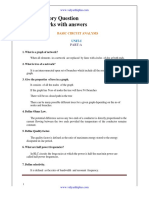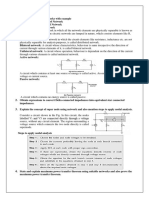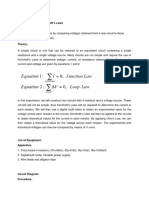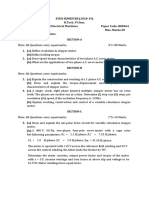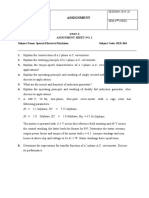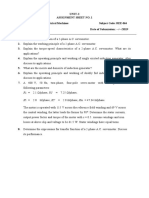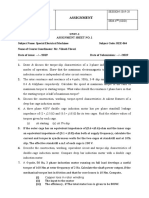0 ratings0% found this document useful (0 votes)
15 viewsQuestions: DC Analysis
The document provides instructions on solving various circuit analysis problems using different techniques like mesh equation method, nodal analysis, superposition theorem, and Thevenin's and Norton's theorems. It also defines passive and active components, unilateral and bilateral elements, and linear and non-linear systems. Finally, it asks the reader to state and prove the maximum power transfer theorem.
Uploaded by
Vikash TiwariCopyright
© © All Rights Reserved
Available Formats
Download as PDF, TXT or read online on Scribd
0 ratings0% found this document useful (0 votes)
15 viewsQuestions: DC Analysis
The document provides instructions on solving various circuit analysis problems using different techniques like mesh equation method, nodal analysis, superposition theorem, and Thevenin's and Norton's theorems. It also defines passive and active components, unilateral and bilateral elements, and linear and non-linear systems. Finally, it asks the reader to state and prove the maximum power transfer theorem.
Uploaded by
Vikash TiwariCopyright
© © All Rights Reserved
Available Formats
Download as PDF, TXT or read online on Scribd
You are on page 1/ 4
UNIT-1
1:-Using mesh equation method, find the current in resistance R1 of network given below.
2:-Using nodal analysis, find the current through 10 resistor in figure.
4:-Determine current through 8 resister in the following network using super-position theorem.
5:-Find the Thevenins equivalent circuit & Norton's equivalent circuit of the given network.
6:-Find the value of resistance R to have maximum power transfer in the circuit shown in figure. Also
obtain the value of maximum power.
7:-Write short notes on:
(a) Passive and Active component
(i)Active Element: An Active element is one, which supplies Energy to the electric circuit.
Example: Voltage source V and Current source I etc.
(ii)Passive Element: A Passive element is one, which receives energy, and converts into heat or
stored in it. Example: Resister R, Inductor L and Capacitor C.
(b) Unilateral and bilateral elements
(c) Linear and Non-linear system
8:-State and prove maximum power transfer theorem.
You might also like
- Electrical Circuits SE (E&Tc/ELEX) 2020 CourseNo ratings yetElectrical Circuits SE (E&Tc/ELEX) 2020 Course70 pages
- Circuit Theory Question Bank, 2 Marks With AnswersNo ratings yetCircuit Theory Question Bank, 2 Marks With Answers0 pages
- IGNOU - B.Sc. - PHE10: Electrical Circuits and ElectronicsNo ratings yetIGNOU - B.Sc. - PHE10: Electrical Circuits and Electronics323 pages
- Thevenin's Theorem: S. No. Apparatus Range Type QuantityNo ratings yetThevenin's Theorem: S. No. Apparatus Range Type Quantity10 pages
- Superposition Theorem (BTEE-211) (U-1, P-1)No ratings yetSuperposition Theorem (BTEE-211) (U-1, P-1)10 pages
- Circuit Theory Question Bank - CIT EditionNo ratings yetCircuit Theory Question Bank - CIT Edition33 pages
- Fundamentals of Instrumentation EngineeringNo ratings yetFundamentals of Instrumentation Engineering11 pages
- Department of Electronics and Communication EngineeringNo ratings yetDepartment of Electronics and Communication Engineering0 pages
- Question Bank Basic Electrical & Electronics Engineering ElectricalNo ratings yetQuestion Bank Basic Electrical & Electronics Engineering Electrical9 pages
- 19ELC101 Lect 1 Basic Terms and ElementsNo ratings yet19ELC101 Lect 1 Basic Terms and Elements33 pages
- 231EE21 - ECA Tips For Preparaing Exam - Impartant QuestionsNo ratings yet231EE21 - ECA Tips For Preparaing Exam - Impartant Questions5 pages
- Unit 1 - Network Analysis - WWW - Rgpvnotes.inNo ratings yetUnit 1 - Network Analysis - WWW - Rgpvnotes.in17 pages
- Unit1 Practice Questions.docx TA1707675008154 (1)No ratings yetUnit1 Practice Questions.docx TA1707675008154 (1)5 pages
- Full Electrical Electronic Exits Solve(1)No ratings yetFull Electrical Electronic Exits Solve(1)60 pages
- Design of Electrical Circuits using Engineering Software ToolsFrom EverandDesign of Electrical Circuits using Engineering Software ToolsNo ratings yet
- Demagnetizing Characteristics Using B-H LoopNo ratings yetDemagnetizing Characteristics Using B-H Loop2 pages
- X1 = 2.0 Ω/phase; X2' = 2.0 Ω/phase; Xm = 47.34 Ω/phaseNo ratings yetX1 = 2.0 Ω/phase; X2' = 2.0 Ω/phase; Xm = 47.34 Ω/phase1 page
- Assignment: Assignment Sheet No. 1 Subject Name: Special Electrical Machines Subject Code: REE-064No ratings yetAssignment: Assignment Sheet No. 1 Subject Name: Special Electrical Machines Subject Code: REE-0641 page
- Assignment Sheet No. 1 Subject Name: Special Electrical Machines Subject Code: REE-064No ratings yetAssignment Sheet No. 1 Subject Name: Special Electrical Machines Subject Code: REE-0641 page
- Assignment Sheet No. 1 Subject Name: Special Electrical Machines Subject Code: REE-064No ratings yetAssignment Sheet No. 1 Subject Name: Special Electrical Machines Subject Code: REE-0642 pages
- Vishveshwarya Group of Institutions: First Sessional Test, Even Semester Examination 2016-17No ratings yetVishveshwarya Group of Institutions: First Sessional Test, Even Semester Examination 2016-172 pages
- Special Electrical Machines: Unit-3: Stepper Motor & Switched Reluctance MotorNo ratings yetSpecial Electrical Machines: Unit-3: Stepper Motor & Switched Reluctance Motor51 pages
- Niet - Greater Noida B.Tech.-EN-VI SEM. (A+B+C) Assignment-2/ Ree-602/Microprocessor Doa: DosNo ratings yetNiet - Greater Noida B.Tech.-EN-VI SEM. (A+B+C) Assignment-2/ Ree-602/Microprocessor Doa: Dos1 page
- Noida Institute of Engineering & Technology, Greater Noida: Section - ANo ratings yetNoida Institute of Engineering & Technology, Greater Noida: Section - A3 pages
- B.Tech. (VI Semester) PUT Examination Digital Control SystemNo ratings yetB.Tech. (VI Semester) PUT Examination Digital Control System3 pages
- Circuit Theory Question Bank, 2 Marks With AnswersCircuit Theory Question Bank, 2 Marks With Answers
- IGNOU - B.Sc. - PHE10: Electrical Circuits and ElectronicsIGNOU - B.Sc. - PHE10: Electrical Circuits and Electronics
- Thevenin's Theorem: S. No. Apparatus Range Type QuantityThevenin's Theorem: S. No. Apparatus Range Type Quantity
- Department of Electronics and Communication EngineeringDepartment of Electronics and Communication Engineering
- Question Bank Basic Electrical & Electronics Engineering ElectricalQuestion Bank Basic Electrical & Electronics Engineering Electrical
- 231EE21 - ECA Tips For Preparaing Exam - Impartant Questions231EE21 - ECA Tips For Preparaing Exam - Impartant Questions
- Design of Electrical Circuits using Engineering Software ToolsFrom EverandDesign of Electrical Circuits using Engineering Software Tools
- X1 = 2.0 Ω/phase; X2' = 2.0 Ω/phase; Xm = 47.34 Ω/phaseX1 = 2.0 Ω/phase; X2' = 2.0 Ω/phase; Xm = 47.34 Ω/phase
- Assignment: Assignment Sheet No. 1 Subject Name: Special Electrical Machines Subject Code: REE-064Assignment: Assignment Sheet No. 1 Subject Name: Special Electrical Machines Subject Code: REE-064
- Assignment Sheet No. 1 Subject Name: Special Electrical Machines Subject Code: REE-064Assignment Sheet No. 1 Subject Name: Special Electrical Machines Subject Code: REE-064
- Assignment Sheet No. 1 Subject Name: Special Electrical Machines Subject Code: REE-064Assignment Sheet No. 1 Subject Name: Special Electrical Machines Subject Code: REE-064
- Vishveshwarya Group of Institutions: First Sessional Test, Even Semester Examination 2016-17Vishveshwarya Group of Institutions: First Sessional Test, Even Semester Examination 2016-17
- Special Electrical Machines: Unit-3: Stepper Motor & Switched Reluctance MotorSpecial Electrical Machines: Unit-3: Stepper Motor & Switched Reluctance Motor
- Niet - Greater Noida B.Tech.-EN-VI SEM. (A+B+C) Assignment-2/ Ree-602/Microprocessor Doa: DosNiet - Greater Noida B.Tech.-EN-VI SEM. (A+B+C) Assignment-2/ Ree-602/Microprocessor Doa: Dos
- Noida Institute of Engineering & Technology, Greater Noida: Section - ANoida Institute of Engineering & Technology, Greater Noida: Section - A
- B.Tech. (VI Semester) PUT Examination Digital Control SystemB.Tech. (VI Semester) PUT Examination Digital Control System


















